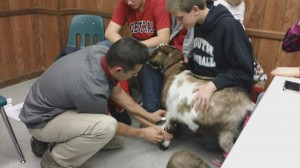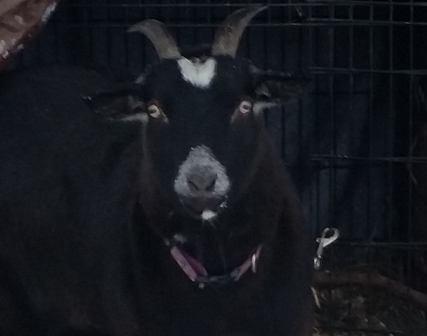The Somerset County 4-H Just Kidding Goat Club recently invited Joe Martins, DVM, to present on the topic “How to Evaluate a Healthy Goat.” Following are the points made during the presentation.

How to approach a goat for an exam
The only way to know what is abnormal about your goat is to first become aware of what is normal. Before I go to a property to evaluate a goat or herd, I ask the owners to contain the herd in a small area or pen and let them be a little hungry so I can help calm them with food when I arrive. Then I follow a few simple steps:
- Talk to the owner first to get a history of the animal
- View the goats from a distance and observe their behavior. Are they chewing their cud? Are they walking properly or limping?
- Once inside the pen, I pet the goat’s chin and offer food to calm the goat. I don’t try to separate one out on its own, as this will cause stress and the vital signs to increase giving inaccurate readings.
- Check three vital signs – Temperature, Pulse, Respiration

Checking Vital Signs
It’s important to check the TPR’s during an exam – Temperature, Pulse and Respiration. A normal temperature for a goat is 101.5 – 103.5 degrees. A normal pulse and heart rate us around 100. A normal respiration is 12-24.
Vitals can become elevated due to pain, inflammation, infection or cancer. Even heat and stress can cause vitals to rise. That’s why is a good idea to compare current vitals to the previous history to look for changes.
Veterinarians are trained to do a 12 point physical exam. We want to examine an animal the same way every time. I start from the face and make my way back and down to check the throat, heart, lungs, legs, tail and hooves.

Diet
The best way the ensure your goat’s shiny coat is to feed him/her a balanced, good diet all year long. This is part of good husbandry.
In general, Timothy grass is recommended over alfalfa (which is too calcium rich) or straw (which has no nutrients). Supplementing with a salt block or goat specific mineral block might work for some goats. Others won’t touch the block (remember, goats have no upper teeth) and therefore loose minerals in a pan will be better. Baking soda in a pan and adding sunflower seeds to their diet which are high in fatty acids is also recommended.
Grain should be a minimal part of a goat’s diet. Male goats are subject to urinary stones that can be very serious and even fatal. Giving them too much grain is a big contributor to them blocking. Sometimes euthanization is the unfortunate alternative to surgery for a blocked goat. This outcome can be avoided by minimizing grain.
Cud-chewing and Bloat
Because rumination is an essential part of how goats digest food, you can use cud-chewing habits as an indicator of goat health. If a goat is not chewing his cud, that tells me something is going on.
Goats can bloat, sometimes so much so that without immediate veterinary care to alleviate the pressure, the goat could die within hours. There are many reasons why a goat will bloat. One cause is they eat too much grain at one time. Therefore, never leave a barrel of grain in the pen where they can free-feed.
Caseous Lymphadenitis (CL)
Caseous Lymphadenitis (CL) is a common bacterial disease in goats. It’s a serious disease because one diseased goat introduced into a new herd can easily infect the entire herd. The result can be death of herd in just a few years’ time.
Symptoms of CL appear as welts that grow and spread over time while the goat’s health deteriorates. Since a goat can easily become infected through an open wound, it’s important to keep fencing in tact and allow your vet to treat any wounds or open sores as soon as possible.
CL can be easily detected by a simple, inexpensive blood test. Your veterinarian can send a blood sample to the State of New Jersey. Therfore, when considering taking in a new goat into the herd, always have its blood tested for CL first, then quarantine the goat for at least two weeks, even if no CL is detected.
Only goats cleared of CL and those with no open wounds or sores should attend the 4-H Fair to minimize the risk.

Caprine Arthritis Encephalitis (CAE)
Caprine Arthritis Encephalitis (CAE) is a virus that affects goats via infected colostrum, milk, or blood. It is not passed from feces, breeding, or sharing food and water. A blood test can determine whether or not a goat is infected.
Tetanus
Horses and goats are the two animals most likely to be infected by Tetanus. We give goats a tetanus toxoid for one year protection. Exposed without the vaccine, a goat can fall ill, develop lockjaw and eventually die.
Recommended Reading:
Update on Dallas and his family
Dr. Joe Martins, DVM, Belle Mead Animal Hospital



